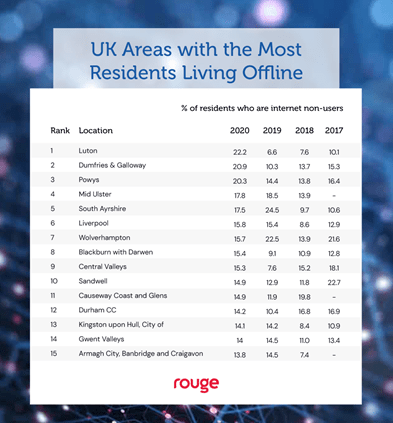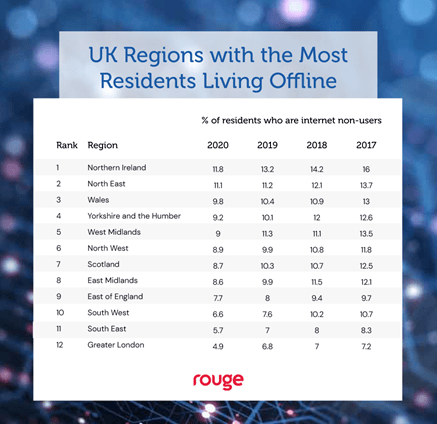26th April 2021
In the Government’s 2014 “Digital Inclusion Strategy”, the target was set to ensure everyone who can be digitally capable will be by 2020.
Our new analysis of the latest data released by the ONS reveals the number of lapsed and internet non-users in the UK was at an all-time low at the start of the COVID-19 pandemic. Despite this, over 4 million residents were still living offline.
In the first three months of 2020, 4.16 million UK residents had never used the internet or hadn’t used it in the past three months compared to 4.8 million in 2019 before the pandemic hit. This is a year-on-year decrease of 633,000 people.
Over recent years, there’s been a growing focus on so-called “internet non-users” as part of the debate about the UK’s digital divide and its impact on inclusion. And the COVID-19 pandemic has exposed the digital divide like never before, as communication and many vital services moved online.
Importantly, the percentage of people who live without internet access has reduced across all age groups between 2019 and 2020 at a time when being online has never been so vital.
Just 0.2 percent of young people aged 16-24 were living offline in early 2020 – 15,000 people, down from 20,000 in 2019. And encouragingly, the number of older people who have never used the internet is down by the largest margin – from 47 percent of over 75s in 2019 to 38.8 percent in 2020.
By analysing local and regional differences in internet non-use, we have also uncovered where in the UK has the highest percentage of lapsed and internet non-users.
At a local level, Luton, Bedfordshire has the largest number of internet non-users proportionate to its population. The number of residents who have never used the internet or haven’t used it in the past three months rose from 6.6 percent in 2019 to a staggering 22.2 percent in 2020.
This means many local residents were left unable to access important online services or benefit from communication apps during the first national lockdown last year.
Given that the percentage of residents over the age of 60 in Luton is lower than the national average, the data points to other social or economic factors at play, with widening inequalities caused by the pandemic perhaps playing a role. The town’s economy has been hardest hit by the loss of revenue from Luton Airport during the pandemic, with the council’s finance chief estimating a £70m shortfall in real terms.

Ranked in second place is Dumfries and Galloway in Scotland with 20.9 percent of its population living offline in 2020 (up from 10.3 percent in 2019). From 12,000 lapsed and internet non-users in 2019, Dumfries and Galloway’s digital divide has since more than doubled in size, with 26,000 people who have either not accessed the internet in the last 3 months or never at all.
The area is known for its rurality and natural beauty, with councillors recently opposing a power line installation that would compromise this. Internet speeds are also poor in parts of the council area – 43.69 percent worse than the United Kingdom national average of 32.98 Mbps, leaving some rural residents unable to connect or with frustratingly slow access.
The area’s age demographics could also be responsible for its digital divide, with 16–24-year-olds being the smallest age bracket in Dumfries and Galloway while 26 percent of the population is over the age of 65.
Powys in Wales follows closely behind in third place – 20.3 percent of its population lived without the internet in 2020 compared to 14.4 percent the year before. The number of lapsed and internet non-users in Powys has now remained consistently higher than the national average for four years running.
Interestingly, the major city of Liverpool features sixth in the UK for highest percentage of residents living offline (15.8 percent), and Wolverhampton also bags a top 10 spot – it placed seventh with 15.7 percent of residents identified as lapsed or internet non-users.
Looking at the data at a regional level, the digital divide is largest in Northern Ireland – with 11.8 percent of residents reporting they haven’t used the internet in the past three month or have never used it.
Although 174,000 people report living offline in Northern Ireland, its digital divide is closing at an encouraging rate, falling over 25 percent between 2017 and 2020. Openreach have just announced plans to invest £100m into NI broadband, hopefully encouraging even more of the population to get online:

Ranked in second place is the North East, with 11 percent of residents living offline at the start of the pandemic – only 0.7 percent behind Northern Ireland. However, its hoped that this will drop further after the region’s superfast broadband upgrade in November 2020.
Since 2017, the North East’s digital divide has closed by 19 percent and just 0.1 percent compared to 2019.
Wales comes in third place for its digital divide, with 9.8 percent of its residents either lapsed or internet non-users in 2020 – down from 10.4 percent in 2019.
Unsurprisingly, Greater London has the smallest percent of the population living offline. One of the factors influencing London’s smaller digital divide is its population is comparatively young; the average age in London is 35.6, compared to 40.3 in the UK overall.
In Inner London, almost half the population is in their early twenties to early forties (46.7 percent), compared to 30.9 percent in the rest of England. Much of the city is made up of the ‘young professional’ demographic, however there are still 347,000 people living offline out of the 9 million residents. Since 2017, London’s digital divide has closed by an impressive 31 percent.
As the portion of the population who were born before the internet becomes smaller and the first generation of “digital natives” reach adulthood, the digital divide is expected to close further and at an accelerated rate across the whole of the UK
However, enduring social and economic issues will remain, preventing people from using or benefiting from the internet fully. The COVID-19 pandemic has increased inequalities between rich and poor households, squeezing budgets further.
According to the Resolution Foundation thinktank, British families took a bigger hit to their income during the pandemic than their European counterparts due to the structure of the UK economy and rising income inequality. This could impact the number of households who are able to afford internet access and IT equipment, with other vital goods and services being prioritised.
You can read more about the study and explore the findings on an interactive map here.
Methodology:
Internet non-users are defined as any adult (aged 16+) who has not used the internet in the last 3 months, or who has never used the internet at all.
The data used in this piece was released by the Office for National Statistics in April 2021. This was the latest available data at the time of writing for regions and council areas.
Where the ONS data split locations into multiple areas, the data for a particular location was combined to produce an average overall result.
E.G. The data for North Nottinghamshire and South Nottinghamshire was combined to produce an average result for Nottinghamshire.





